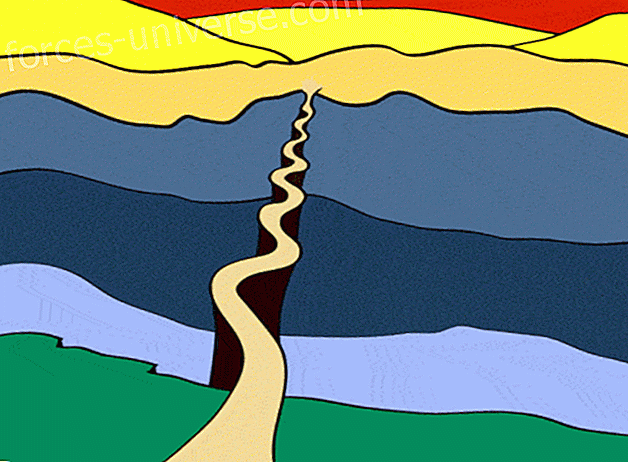The prophecies say that we are about to start a new Golden Age. It is possible that the previous Golden Age was reached just before the thaw, during the last glacial maximum, now 20 thousand years ago. Let's see what could happen then
Introduction
THE OFFICIAL VERSION of history states that 20 thousand years ago we were living on hunting and gathering. He says that the first urban centers were not born until between 5 and 10 thousand years ago. Instead, others speak of Atlantis or Lemuria, as if at that time the world was divided into two nations, one in the middle of the Atlantic Ocean (Atlantis) and the other in the Pacific (Lemuria ). They constitute two extreme interpretations of the past, and as is often the case, the truth must be somewhere in between.

25 thousand years ago: Golden Age
Thus, in my opinion, during the previous Golden Age, we lived in city-states, and those who were not organized in such a way did so in tribal communities. They were cities that everything and preserve their independence, formed a network. Cities that sympathized and helped each other in the purest aquarium style. This happened during the previous Age of Aquarius, 25 thousand years ago. At that time we were still immersed in a glacial period.
The vast majority of city-states were located by the sea, for the following reasons:
- Because we were in a glacial period, it was colder or cold at high latitudes and altitudes, while temperatures near the tropics and at sea level were very similar to the current ones. Hence the weather near the sea was much more pleasant.
- In addition, the water level had remained relatively stable for thousands of years. Such stability has caused the old coastline to be appreciable from any satellite photo. In these photos we observe a blue-blue strip, located between the navy blue of the greatest depths and the current coastline. Such a strip indicates the area that was not submerged during the more than two million years that the glaciation is said to last. The erosion caused by the sea during those two million years gave depth to the dark blue strip. Meanwhile, the low erosion suffered during the last 10 to 15 thousand years makes recently submerged lands still shallow.

- Third, the sea is an important source of food.
- And finally, the ocean allows mobility using wind energy, without the need to build special infrastructure such as roads, or use the wheel.
20 thousand years ago: Decline
But living in coastal areas made the population much more vulnerable to an eventual increase in water levels. Besides, those who did not live on the coast did so in the great river valleys, which were also flooded when the glaciers that fed the rivers melted. Therefore, when the last glacial maximum was reached 20 thousand years ago and the ice began to melt and the sea level to rise, the population of the moment sensed that a change in trend had just taken place and that something terrible was brewing.
The city-states of the moment had to go into decline. The population surely began to move, looking for new lands to occupy in the highest areas. This created tensions that caused the return of war conflicts, which had been absent during the Golden Age. The city-states began fighting each other, or grouped together constituting nations, to declare war on a third party. The wise men ceased to govern, who do it by example, through the so-called magisterial government, and more autocratic leaders began to appear, who eventually gave command to their descendants, many of them inept. Five thousand years later, at the end of that Era, the political map of the world had changed completely. When talking about Atlantis, surely one is referring to one of the nations that emerged from the grouping of several city-states.
15 thousand years ago: Age of the Flood
Then, about 15 thousand years ago, the Age of the Flood began, with its climatic instability even more pronounced, accelerated thaw and, perhaps, seismic phenomena of importance. Periods of rapid thawing flooded the valleys and suddenly increased the water level, further submerging the coastal areas. At that time there was little left of that Golden Age. The few city-states located far from the coast and on land that was not flooded by the rivers, suffered harassment of the refugees, so they were destroyed by real human tidal waves.
Legends of India tell us how Manu, with seven wise men, took samples of seeds and took refuge in the high mountains of the Himalayas. Greek legends tell us how Deucalion and Pirra also managed to escape, to continue Greek civilization elsewhere. The Inkas legends explain to us how Manco Cápac and Mama Ocllo were sent by Father Sun to take the survivors out of the flood of the state of hardship in which they had remained. The Bible tells us about Noah . Sumerian legends tell us about Ziusura . Chinese legends do it from Yu the Great, son of Gun, who built dikes to protect himself from the rise of the rivers. Many are the stories and cultures that tell us similar events.
10 thousand years ago: Neolithic Revolution
Those who survived took refuge where they could, to return the calm, start the fourth Era, the one that has been interpreted by historians as the Neolithic revolution. Such a revolution would not have been possible had it not been for the seeds and knowledge that were still preserved. That is to say, many crops reappear suddenly, about 10, 000 years ago, without a clear evolutionary line being seen from its wild to the domesticated form. An example of this sudden appearance of knowledge is in the city of Çatalhöyük, south of the Anatolian peninsula. And many knowledge, both handmade and architectural, also appear in the same way.

Meanwhile, in the Andes ...
Some of the survivors took refuge in the high mountain ranges of the Andes. Judging by the legends, these were first established in the area of Lake Titicaca, although its previous point of origin is unknown. Maybe they came from that strip of the South American continent that had sunk beneath the waters. Maybe they did it from the low river valleys, that everything and not be covered by the sea, if they were flooded by the melting of the Andean glaciers. Or, perhaps, they did it from farther lands.
What seems certain is that they were initiated who had preserved some of the knowledge gained during the previous Golden Age. Therefore, aware that 10 thousand years later, only the memory of the stones would remain, they built places like Sacsauhuaman to testify to their existence.
During the next two Eras, the Andean area experienced the alternation and cyclical inversion of cultures. Some arrived, others left, and if we pay attention to their interpretation of time in cycles of five hundred years, it is assumed that such was the approximate pattern that governed the process. However, being aware of the law of alternation and that of cyclical investment, the conquering culture instead of destroying the world of the conquered, built on its foundations. Such a reaction is clear when the ninth Inca, Pachacútec, instead of suppressing and reinventing the history of the conquered territories, respects it to even enhance it, as the chronicles of Pedro Sarmiento de Gamboa tell us.
Hence, when we talk about the Inkas, one may be referring only to those two dynasties and thirteen rulers who reigned during the eighth pachacuti (1000 AD to 1500 AD). But when we talk about an Inca or Andean worldview, we necessarily have to refer to the 10 thousand years of history that created it, to even go further. Go to the time before the flood, until the last golden age, possibly started 25 thousand years ago.
2011, Marc Torra (Urus) for mastay.info






